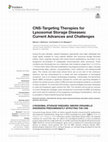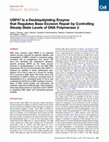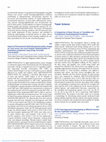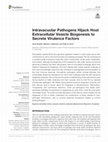Papers by Mariola J . Ferraro

Frontiers in Molecular Biosciences, Nov 12, 2020
During the past decades, several therapeutic approaches have been developed and made rapidly avai... more During the past decades, several therapeutic approaches have been developed and made rapidly available for many patients afflicted with lysosomal storage disorders (LSDs), inborn organelle disorders with broad clinical manifestations secondary to the progressive accumulation of undegraded macromolecules within lysosomes. These conditions are individually rare, but, collectively, their incidence ranges from 1 in 2,315 to 7,700 live-births. Most LSDs are manifested by neurological symptoms or signs, including developmental delay, seizures, acroparesthesia, motor weakness, and extrapyramidal signs. The chronic and later-onset clinical forms are at one end of the continuum spectrum and are characterized by a subtle and slow progression of neurological symptoms. Due to its inherent physiological properties, unfortunately, the blood-brain barrier (BBB) constitutes a significant obstacle for current and upcoming therapies to achieve the central nervous system (CNS) and treat neurological problems so prevalent in these conditions. To circumvent this limitation, several strategies have been developed to make the therapeutic agent achieve the CNS. This narrative will provide an overview of current therapeutic strategies under development to permeate the BBB, and address and unmet need for treatment of the progressive neurological manifestations, which are so prevalent in these inherited lysosomal disorders.
Journal of Biomedicine and Biotechnology, 2011
Strong cation exchange (SCX) chromatography has been utilized as an excellent separation techniqu... more Strong cation exchange (SCX) chromatography has been utilized as an excellent separation technique that can be combined with reversed-phase (RP) chromatography, which is frequently used in peptide mass spectrometry. Although SCX is valuable as the second component of such two-dimensional separation methods, its application goes far beyond efficient fractionation of complex peptide mixtures. Here I describe how SCX facilitates mapping of the protein posttranslational modifications (PTMs), specifically phosphorylation and N-terminal acetylation. The SCX chromatography has been mainly used for enrichment of these two PTMs, but it might also be beneficial for high-throughput analysis of other modifications that alter the net charge of a peptide.

Journal of clinical and translational science, Apr 1, 2023
environmental exposure; (2) geospatial and demographic inequality (historic and current) around h... more environmental exposure; (2) geospatial and demographic inequality (historic and current) around housing/neighborhood conditions contributing to disproportionate environmental exposures for low-income and minoritized residents; (3) health implications of environmental exposures; (4) prior policy addressing the connections between housing/neighborhoods and environmental risk; and (5) future policy recommendations to improve housing/neighborhood quality and minimize environmental exposures for residents. DISCUSSION/SIGNIFICANCE: This project will illuminate connections between housing conditions and environmental exposures, health implications of these exposures, and contribute to advancing understanding of potential policies to reduce adverse environmental health impacts of poor housing conditions for residents (particularly for low-income, minoritized groups).
Molecular and Cellular Biology, Aug 1, 2010

Frontiers in Immunology, Apr 20, 2021
Extracellular vesicles (EVs) have garnered significant interest in recent years due to their cont... more Extracellular vesicles (EVs) have garnered significant interest in recent years due to their contributions to cell-to-cell communication and disease processes. EVs are composed of a complex profile of bioactive molecules, which include lipids, nucleic acids, metabolites, and proteins. Although the biogenesis of EVs released by cells under various normal and abnormal conditions has been well-studied, there is incomplete knowledge about how infection influences EV biogenesis. EVs from infected cells contain specific molecules of both host and pathogen origin that may contribute to pathogenesis and the elicitation of the host immune response. Intracellular pathogens exhibit diverse lifestyles that undoubtedly dictate the mechanisms by which their molecules enter the cell's exosome biogenesis schemes. We will discuss the current understanding of the mechanisms used during infection to traffic molecules from their vacuolar niche to host EVs by selected intravacuolar pathogens. We initially review general exosome biogenesis schemes and then discuss what is known about EV biogenesis in Mycobacterium, Plasmodium, Toxoplasma, and Leishmania infections, which are pathogens that reside within membrane delimited compartments in phagocytes at some time in their life cycle within mammalian hosts. The review includes discussion of the need for further studies into the biogenesis of EVs to better understand the contributions of these vesicles to hostpathogen interactions, and to uncover potential therapeutic targets to control these pathogens.
Zoonoses, 2022
The other reviewer chose to be anonymous.

Chemico-Biological Interactions, Oct 1, 2011
Oxidative stress in cells and tissues leads to the formation of an assortment of lipid electrophi... more Oxidative stress in cells and tissues leads to the formation of an assortment of lipid electrophiles, such as the quantitatively important 4-hydroxy-2-trans-nonenal (HNE). Although this cytotoxic aldehyde is atherogenic the mechanisms involved are unclear. We hypothesize that elevated HNE levels can directly inactivate esterase and lipase activities in macrophages via protein adduction, thus generating a biochemical lesion that accelerates foam cell formation and subsequent atherosclerosis. In the present study we examined the effects of HNE treatment on esterase and lipase activities in human THP1 monocytes/macrophages at various physiological scales (i.e., pure recombinant enzymes, cell lysate, and intact living cells). The hydrolytic activities of bacterial and human carboxylesterase enzymes (pnbCE and CES1, respectively) were inactivated by HNE in vitro in a time-and concentration-dependent manner. In addition, so were the hydrolytic activities of THP1 cell lysates and intact THP1 monocytes and macrophages. A single lysine residue (Lys105) in recombinant CES1 was modified by HNE via a Michael addition reaction, whereas the lone reduced cysteine residue (Cys389) was found unmodified. The lipolytic activity of cell lysates and intact cells was more sensitive to the inhibitory effects of HNE than the esterolytic activity. Moreover, immunoblotting analysis using HNE antibodies confirmed that several cellular proteins were adducted by HNE following treatment of intact THP1 monocytes, albeit at relatively high HNE concentrations (>50 µM). Unexpectedly, in contrast to CES1, the treatment of a recombinant human CES2 with HNE enhanced its enzymatic activity ~3-fold compared to untreated enzyme. In addition, THP1 monocytes/macrophages can efficiently metabolize HNE, and glutathione conjugation of HNE is responsible for ~43% of its catabolism. The functional importance of HNE-mediated inactivation of cellular hydrolytic enzymes with respect to atherogenesis remains obscure, although this study has taken a first step toward addressing this important issue by examining the potential of HNE to inhibit this biochemical activity in a human monocyte/macrophage cell line.

Behavioural Brain Research, Dec 1, 2019
Abstract Social play is the most characteristic form of social interaction which is necessary for... more Abstract Social play is the most characteristic form of social interaction which is necessary for adolescents to develop proper cognitive, emotional, and social competency. The information available on neural substrates and the mechanism involved in social play is limited. This study characterized social play by proteomic and transcriptional profiling studies. Social play was performed on male Sprague Dawley rats on postnatal day 38 and protein and gene expression in the amygdala was determined following behavioral testing. The proteomic analysis led to the identification of 170 differentially expressed proteins (p ≤ 0.05) with 67 upregulated and 103 downregulated proteins. The transcriptomic analysis led to the identification of 188 genes (FDR ≤ 0.05) with 55 upregulated and 133 downregulated genes. DAVID analysis of gene/protein expression data revealed that social play altered GABAergic signaling, glutamatergic signaling, and G-protein coupled receptor (GPCR) signaling. These data suggest that the synaptic levels of GABA and glutamate increased during play. Ingenuity Pathway Analysis (IPA) confirmed these alterations. IPA also revealed that differentially expressed genes/proteins in our data had significant over representation of neurotransmitter signaling systems, including the opioid, serotonin, and dopamine systems, suggesting that play alters the systems involved in the regulation of reward. In addition, corticotropin-releasing hormone signaling was altered indicating that an increased level of stress occurs during play. Overall, our data suggest that increased inhibitory GPCR signaling in these neurotransmitter pathways occurs following social play as a physiological response to regulate the induced level of reward and stress and to maintain the excitatory-inhibitory balance in the neurotransmitter systems.

PLOS ONE, Feb 20, 2014
Lysine acetylation is a reversible, dynamic protein modification regulated by lysine acetyltransf... more Lysine acetylation is a reversible, dynamic protein modification regulated by lysine acetyltransferases and deacetylases. Recent advances in high-throughput proteomics have greatly contributed to the success of global analysis of lysine acetylation. A large number of proteins of diverse biological functions have been shown to be acetylated in several reports in human cells, E.coli, and dicot plants. However, the extent of lysine acetylation in non-histone proteins remains largely unknown in monocots, particularly in the cereal crops. Here we report the mass spectrometric examination of lysine acetylation in rice (Oryza sativa). We identified 60 lysine acetylated sites on 44 proteins of diverse biological functions. Immunoblot studies further validated the presence of a large number of acetylated non-histone proteins. Examination of the amino acid composition revealed substantial amino acid bias around the acetylation sites and the amino acid preference is conserved among different organisms. Gene ontology analysis demonstrates that lysine acetylation occurs in diverse cytoplasmic, chloroplast and mitochondrial proteins in addition to the histone modifications. Our results suggest that lysine acetylation might constitute a regulatory mechanism for many proteins, including both histones and non-histone proteins of diverse biological functions.

Molecular Cell, Mar 1, 2011
DNA base excision repair (BER) is an essential cellular process required for genome stability, an... more DNA base excision repair (BER) is an essential cellular process required for genome stability, and misregulation of BER is linked to premature aging, increased rate of mutagenesis, and cancer. We have now identified the cytoplasmic ubiquitinspecific protease USP47 as the major enzyme involved in deubiquitylation of the key BER DNA polymerase (Pol b) and demonstrate that USP47 is required for stability of newly synthesized cytoplasmic Pol b that is used as a source for nuclear Pol b involved in DNA repair. We further show that knockdown of USP47 causes an increased level of ubiquitylated Pol b, decreased levels of Pol b, and a subsequent deficiency in BER, leading to accumulation of DNA strand breaks and decreased cell viability in response to DNA damage. Taken together, these data demonstrate an important role for USP47 in regulating DNA repair and maintaining genome integrity.

Journal of clinical and translational science, Apr 1, 2022
An increasing number of hospitals and provider groups are consolidating into larger health system... more An increasing number of hospitals and provider groups are consolidating into larger health systems, which hold potential to improve access to and quality of surgical cancer care through clinical integration across sites. In order to study clinical integration, we sought to develop: METHODS/STUDY POPULATION: Hospital data from the American Hospital Association were merged with data from the Agency for Healthcare Research and Quality's Compendium of United States Health Systems. For each health system with more than one acute care hospital, the hospital with the highest surgical volume (inpatient and outpatient) was categorized as the hub hospital while all other hospitals were categorized as spokes. We evaluated the concentration of case volumes at hub versus spoke hospitals and compared characteristics of these hospitals and their surrounding communities using univariate and multivariable logistic regression analyses. RESULTS/ ANTICIPATED RESULTS: Within 624 health systems containing 3,554 hospitals, 355 hospitals were characterized as hub hospitals and had 2,645 affiliated spoke hospitals (median 17 spokes per hub, range 2-151). Hub hospitals performed a median of 68% of all surgical cases (25th-75th percentile 44-87%) and were concentrated in metropolitan (88.5%) and urban areas (11.5%) with none in rural areas; spoke hospitals were located in metropolitan (67%), urban (28%) and rural (5%) areas. On multivariable analysis, spoke hospitals were more often located in rural and small urban counties (OR 9.49, CI 4.57-19.70) and took care of a higher percentage of patients with less than high school education (OR 1.06 for each 1% increase, CI 1.03-1.10) but with lower poverty rates (OR 0.90 for each 1% increase in % poverty, CI 0.86-0.95). DISCUSSION/SIGNIFICANCE: For integrated health systems with multiple acute care hospitals, surgical volume is highest at a single hub hospital, supporting use of a hub-spoke taxonomy. Patient populations in counties with hub versus spoke hospitals differ in urban-rural location, poverty rates, and education level, which may impact access to quality care.
Microbiology spectrum, Jun 15, 2023

International Journal of Hyperthermia, 2020
Macrophages play a dual role in tumor initiation and progression, with both tumor-promoting and t... more Macrophages play a dual role in tumor initiation and progression, with both tumor-promoting and tumor-suppressive effects; hence, it is essential to understand the distinct responses of macrophages to tumor progression and therapy. Mild hyperthermia has gained importance as a therapeutic regimen against cancer due to its immunogenic nature, efficacy, and potential synergy with other therapies, yet the response of macrophages to molecular signals from hyperthermic cancer cells has not yet been clearly defined. Due to limited response rate of breast cancer to conventional therapeutics the development, and understanding of alternative therapies like hyperthermia is pertinent. In order to determine conditions corresponding to mild thermal dose, cytotoxicity of different hyperthermic temperatures and treatment durations were tested in normal murine macrophages and breast cancer cell lines. Examination of exosome release in hyperthermia-treated cancer cells revealed enhanced efflux and a larger size of exosomes released under hyperthermic stress. Exposure of naïve murine macrophages to exosomes released from 4T1 and EMT-6 cells posthyperthermia treatment, led to an increased expression of specific macrophage activation markers. Further, exosomes released by hyperthermia-treated cancer cells had increased content of heat shock protein 70 (Hsp70). Together, these results suggest a potential immunogenic role for exosomes released from cancer cells treated with mild hyperthermia.
Journal of extracellular vesicles, Sep 1, 2022
Journal of Proteomics, Aug 1, 2020
Chicken is the first agricultural animal to have a sequenced genome, but current kinase annotatio... more Chicken is the first agricultural animal to have a sequenced genome, but current kinase annotations of Gallus gallus are overwhelmingly limited to the predictions generated based on homology or isolated studies focused on specific kinases. Our approach used .
Biochimica Et Biophysica Acta - Proteins And Proteomics, May 1, 2016
Acs Symposium Series, 2012

Blood Cells Molecules and Diseases, Sep 1, 2009
Hereditary hemochromatosis is most frequently associated with mutations in HFE, which encodes a c... more Hereditary hemochromatosis is most frequently associated with mutations in HFE, which encodes a class Ib histocompatibility protein. HFE binds to the transferrin receptor-1 (TfR1) in competition with iron-loaded transferrin (Fe-Tf). HFE is released from TfR1 by increasing concentrations of Fe-Tf, and free HFE may then regulate iron homeostasis by binding other ligands. To search for new HFE ligands we expressed recombinant forms of HFE in the human cell line 293T. HFE protein was purified, biotinylated and made into fluorescently labelled tetramers. HFE tetramers bound to TfR1 in competition with Tf, but in addition we detected a binding activity on some cell types that was not blocked by Fe-Tf or by mutations in HFE that prevent binding to TfR1. We identified this second HFE ligand as the cation independent mannose-6-phosphate receptor (CI-MPR, also known as the insulin-like growth factor-2 receptor, IGF2R). HFE:CI-MPR binding was mediated through phosphorylated mannose residues on HFE. Recombinant murine Hfe also bound to CI-MPR. HFE bound to TfR1 was prevented from binding CI-MPR until released by increasing concentrations of Fe-Tf, a feature consistent with an iron sensing mechanism. However, it remains to be determined whether endogenous HFE in vivo also acquires the mannose-6 phosphate modification and binds to CI-MPR.

Journal of Clinical and Translational Science
OBJECTIVES/GOALS: Non-Typhoidal Salmonella causes over 95 million infections globally each year, ... more OBJECTIVES/GOALS: Non-Typhoidal Salmonella causes over 95 million infections globally each year, and no effective vaccine exists to combat infections in humans. The goal of this study is to determine the immune protection provided by a novel extracellular vesicle (EV)-based vaccine generated using lab-strain Salmonella against wastewater-derived Salmonella. METHODS/STUDY POPULATION: We isolated Non-Typhoidal Salmonella (NTS) from raw influent wastewater samples collected from two wastewater reclamation facilities (WRF) in Gainesville, FL. Whole genome sequencing was performed on each isolate and compared to sequences of clinically-derived isolates in FL during our study period to identify a clinical and subclinical isolate for assessing EV based vaccine protection. Mouse serum and stool samples were collected from a cohort of EV-vaccinated mice. Surrogates of protection against Salmonella used anti-Salmonella IgA in the feces of these mice, and anti-Salmonella IgG in serum of the mi...

Frontiers in Immunology
Extracellular vesicles (EVs) have garnered significant interest in recent years due to their cont... more Extracellular vesicles (EVs) have garnered significant interest in recent years due to their contributions to cell-to-cell communication and disease processes. EVs are composed of a complex profile of bioactive molecules, which include lipids, nucleic acids, metabolites, and proteins. Although the biogenesis of EVs released by cells under various normal and abnormal conditions has been well-studied, there is incomplete knowledge about how infection influences EV biogenesis. EVs from infected cells contain specific molecules of both host and pathogen origin that may contribute to pathogenesis and the elicitation of the host immune response. Intracellular pathogens exhibit diverse lifestyles that undoubtedly dictate the mechanisms by which their molecules enter the cell’s exosome biogenesis schemes. We will discuss the current understanding of the mechanisms used during infection to traffic molecules from their vacuolar niche to host EVs by selected intravacuolar pathogens. We initial...








Uploads
Papers by Mariola J . Ferraro